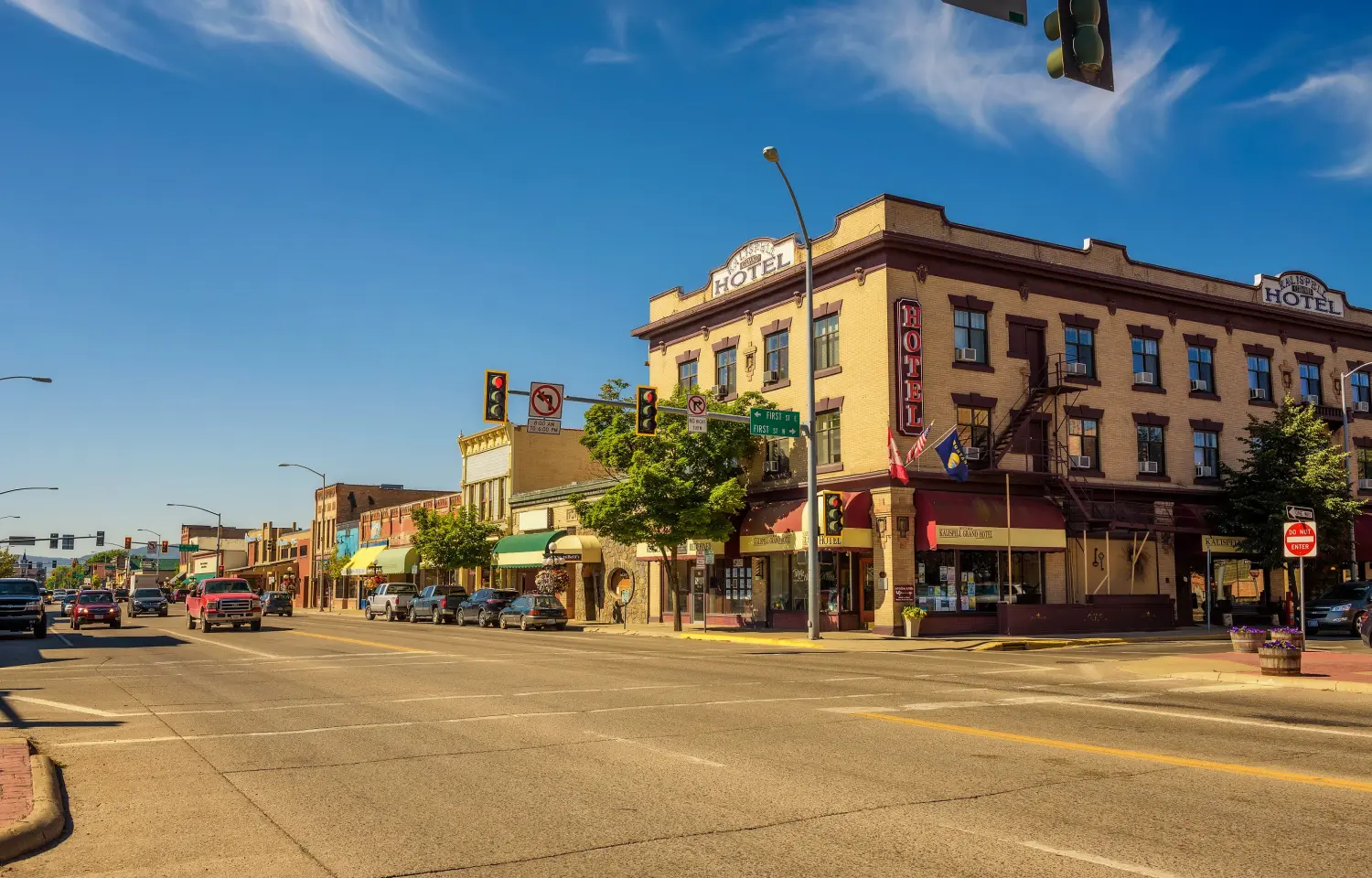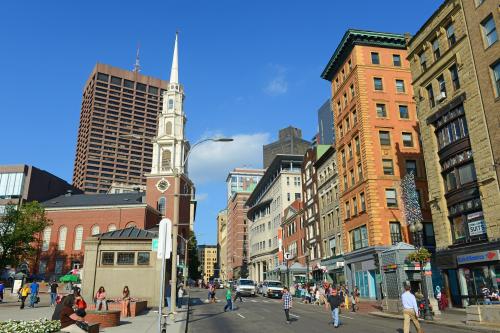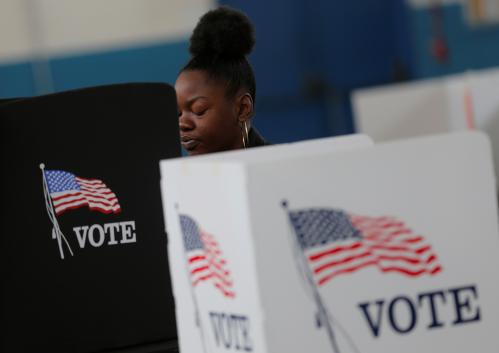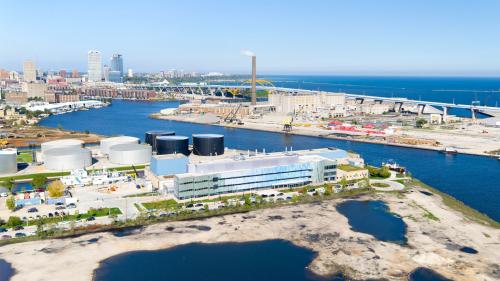Contents
- Why cities matter to rural economies
- A network of nearby cities could be better for rural America than a few big “superstar” cities
- Investments in mid-sized cities can benefit rural communities and the nation
The 2018 midterm elections affirmed that the deep geographic divides within the United States are here to stay. As they did in 2016, Americans living in rural areas overwhelmingly backed Republican candidates, fueled in part by the sense that the American economy is leaving them behind. The plight of rural America, and ideas for its economic revival, continues to animate policy discussions, including among Democrats concerned about their ability to appeal to blue-collar voters.
There are real economic challenges confronting small towns, many of which struggle to add jobs and retain population in today’s knowledge-driven economy. But it would be a mistake to enact policy solutions to save rural America at the expense of cities. Recent efforts to bail out farmers amidst a trade war and exempt rural counties from work requirements to receive Medicaid and other safety-net services in effect hurt people and businesses in cities and suburbs. While these policy moves seem like clever ways to rebalance urban-rural economic divides, they could ultimately harm rural communities, too, by choking off the very engines that make rural investments possible.
In fact, one of the best ways to help rural America may involve helping cities: supporting a distributed network of economically vibrant small and mid-sized cities across the United States.
Why cities matter to rural economies
When looking into urban and rural communities, some context is useful to consider. Many residents in this country, and across the world, continue to move to cities to pursue better lives. Though the fastest rates of urban growth are taking place outside of the United States, America continues to become a more urban nation: Since 2010, metropolitan areas in the United States grew in population by more than 6 percent, while non-metropolitan areas shrank by 0.5 percent.1 Brookings analysis reveals that during this timeframe, metro areas with populations over 1 million gained jobs at the fastest rate, while smaller metro areas and non-metro areas added jobs at progressively slower rates, corresponding with their population size. To be sure, rural areas have experienced an uptick in employment in 2017, and within the longer-term trend of rural decline are countless stories of smaller localities that found ways to maintain, and grow, their populations and economies. But the fundamental reality is that more people will live in cities in the years ahead, regardless of any local, state, or federal policy initiative.
Given this, cities matter greatly to rural revitalization, for at least three key reasons.
- Prosperity in cities and metropolitan areas effectively subsidizes public investments in rural areas. Nationally, many of the states that receive the highest per-capita rates of federal investment have greater shares of their population in rural communities, such as South Carolina, North Dakota, and Louisiana. Meanwhile, many of the states that receive the lowest rates of federal investment have greater shares of their population in urban centers, including Delaware, Illinois, and Ohio.
This pattern holds for state government spending, too. Studies in Minnesota, Georgia, and Wisconsin reveal that metropolitan areas contribute more to state coffers than they receive in education, infrastructure, and other public services investments. In Georgia, for instance, metropolitan Atlanta provides 61 percent of state revenue but receives just 46 percent of state investment. State spending on roads, broadband networks, schools, and other public services in small town America is funded, in part, by the economic prosperity of cities.
- Access to cities—and their markets, specialized industries, and capital—increases rural prosperity. Analysis by our Brookings colleagues Mark Muro and Jacob Whiton suggests that proximity to cities can contribute to rural communities’ well-being due to the spillover benefits that cities generate. Muro and Whiton categorized non-metropolitan counties into ones that are adjacent to a metropolitan area, and ones that are not. While both groups of rural counties experienced job losses between 2008 and 2017, the “non-adjacent” counties fared far worse (Figure 1). Total employment in “adjacent” rural areas declined by 1.9 percent during that time span, but it declined by 3.5 percent in non-adjacent places. In other words, proximity to cities acted as an economic buffer for nearby rural areas, on net, slowing their economic decline.
 Another study found that proximity to urban centers improved residents’ optimism about their community’s long-term job prospects. Just 40 percent of residents in these more proximate communities said that they would advise young people to leave for opportunity elsewhere, compared with 61 percent of residents who lived in towns that were farther from cities.
Another study found that proximity to urban centers improved residents’ optimism about their community’s long-term job prospects. Just 40 percent of residents in these more proximate communities said that they would advise young people to leave for opportunity elsewhere, compared with 61 percent of residents who lived in towns that were farther from cities.
Proximity to cities itself might not be as important as a related attribute: access. Researchers at Headwaters Economics categorized counties in the Western United States into three groups: “metropolitan,” “connected” (defined as rural counties that were connected to the rest of the world through airports with daily service), and “isolated” counties. They found that while “metropolitan” counties performed best, “connected” rural counties had higher rates of educational attainment, population growth, average earnings, and high-wage service jobs, and less income volatility than “isolated” counties did. In other words, the communities that were most closely connected to larger markets did better.
- Cities provide opportunities for ambitious rural residents to gain new skills and experiences, benefitting workers and their home communities. As described in Vox, sociologists Patrick Carr and Maria Kefalas found that some people who leave their rural hometowns end up returning, filling specialized jobs in medicine, law, and other professions using the skills they developed in cities. This phenomenon of “return migration,” popularly referred to as a “boomerang effect,” now animates economic development strategies in several small and mid-sized cities.
To be sure, proximity and access to cities isn’t the sole, or even most important, determinant in a small town’s economic success, as a recent CityLab analysis revealed. Yet these studies reinforce a simple premise. Rather than see rural America as existing in isolation from urban centers, or characterize the two sets of communities as locked in a zero-sum game for economic growth, we should recognize that rural America’s economic success is linked with that of America’s cities.
A network of nearby cities could be better for rural America than a few big “superstar” cities
While city and rural economies retain important, mutually reinforcing linkages, recent trends suggest that the clustering of people, jobs, and capital—known as economic agglomeration—will continue to accelerate into the 21st century. Despite promising employment growth over the past several years, the fact remains that low-density rural areas represent the opposite of what matters in an economy that rewards concentration of knowledge assets. As our colleague Mark Muro notes, the commodity-producing industries that have led to rural America’s recent resurgence, including agriculture, mining, and oil and gas extraction, are not reliable sources of sustained prosperity. Rural communities still have lower shares of residents with college degrees, digital skills, and specialized, knowledge-based jobs, all of which are crucial determinants of durable success in the modern era.
Given market realities and the bleak long-term prospects for many small towns, rural America’s best bet might be to support economic growth in urban centers, including micropolitan areas, and strengthen linkages between urban and rural communities.
Some economists suggest that the United States needs fewer, larger cities. They observe that compared to other developed countries that have just one or two dominant cities (such as London in the United Kingdom, or Sydney and Melbourne in Australia), growth in the U.S. is more evenly distributed. Moreover, larger cities tend to have more productive economies, owing to the benefits of agglomeration. These economists conclude that, because the national economy would grow fastest if more people moved from low-productivity to high-productivity places, public efforts should focus on removing barriers to geographic mobility. They recommend expanding housing supply and transportation options in our country’s biggest cities, and offering relocation assistance for residents in struggling areas.
Policies to make it easier for more people to move to our biggest cities are worth pursuing. But it is not sufficient nor realistic to expect most low-income workers to leave their social networks or afford high-cost areas. A more strategic approach would aim to accelerate economic growth across mid-sized metro areas and micropolitan areas that are accessible to nearby rural areas. Imagine the state of Illinois not just anchored by the Chicago metro area, but by a network of other vibrant communities like Rockford, Peoria, Decatur, and Champaign-Urbana, which in turn offer opportunities for surrounding rural communities. Micropolitan areas like Traverse City, Mich., Corning, N.Y., and Kalispell, Mont. could serve as stronger centers of jobs, finance, and opportunities for rural households. Rather than sprinkle limited resources across every rural county, state and federal policymakers could target efforts to small and mid-sized markets by helping them strengthen commercial corridors and modernize existing industries.
Mid-sized cities closer to rural communities offer another intangible benefit that larger, coastal cities cannot. Author J.D. Vance explained this dynamic at a Brookings event last fall:
There’s a difference between outmigration from Eastern Kentucky to Southwestern Ohio, and Eastern Kentucky and San Diego, because the former allows you to preserve some social connections, it’s cheaper to move there, it’s less culturally intimidating to move there…if we can regionally develop big cities like Lexington, like Pittsburgh, like Columbus, Ohio, … [it] enables people to maintain social connections even as they move to places with higher employment, and still play a positive role in communities back home.
Put another way, mid-size cities, if they can continue to serve as places of growth and opportunity, are better positioned to offer social and economic benefits to rural communities than distant, high-cost cities.
Investments in mid-sized cities can benefit rural communities and the nation
Beyond the benefits to rural areas, investing in mid-sized cities across America is simply good policy. In an economy increasingly defined by concentration and the coasts, cities themselves are in a winner-take-all competition with one another that is resulting in a nation riven by geographic, cultural, and political divides. Amazon’s recent announcement that its headquarters functions will expand to the New York and Washington, D.C. metro areas is merely the latest evidence that the country’s largest markets—and the talent, infrastructure, and amenities they offer—are absorbing the lion’s share of growth while Heartland communities struggle to keep pace.
So what strategies should federal, state, and local leaders pursue to help mid-sized cities grow in a way that benefits rural communities? We believe that four broad approaches would help.
First, restructure economic policymaking to empower communities. Local and regional leaders often have a better sense of what their communities need than state or federal officials. To support economic growth in cities, these officials should provide additional flexibility and resources for smart, cross-sector economic planning at a local scale. States, in particular, have crucial roles to play, and several governors and state legislatures are leading the way on facilitating bottom-up strategies. Under Governor Brian Sandoval, Nevada reoriented its statewide economic strategies toward its regions, establishing regional development authorities, conducting in-depth assessments of industry strengths, and tailoring strategies to regional needs. Virginia passed legislation and new grant programs to facilitate job creation and innovation across the commonwealth through regional collaboration. In Tennessee, Governor Bill Haslam and the state legislature approved a new grant program that incentivizes local solutions to achieve the state’s post-secondary college attainment goals. Other smart policies can help bring stakeholders with diverse viewpoints around a common table to identify key challenges, identify assets to invest in, and ensure that more people benefit from new jobs and investments that result.
Second, align public investments to prioritize homegrown job creation, not recruitment of individual companies. Amazon’s heavily criticized HQ2 search process underscores a reality that more state and local leaders are recognizing in recent years: Public subsidies for business attraction are generally wasteful and not a realistic job creation strategy for smaller communities that cannot compete for headline-grabbing firms like Amazon. Instead, public policies should help small and mid-sized cities promote entrepreneurship and strengthen existing industry clusters where supply chains span urban and rural areas. A report by the National League of Cities demonstrates that efforts to link rural businesses with urban markets can help sustain small town economies, as can be seen through Sacramento’s specialty crops industry cluster. In an excellent essay in Democracy Journal, former Secretary of Agriculture Tom Vilsack identifies promising industries that have the potential to lift up rural and urban communities, including bio-based manufacturing and ecosystem markets. When done well, industry cluster strategies can help legacy firms and sectors evolve, adopt new technologies, and be a source of market growth and distinction in an increasingly competitive global environment.
Third, double down on preparing workers for the modern economy by strengthening existing universities, community colleges, and workforce readiness programs. Digital skills are increasingly valued in today’s economy, and places that provide forward-looking educational opportunities to their students will help prepare them for jobs and launch new businesses. Furthermore, research institutions themselves are economic anchors that bring investment and workers into communities. In a post on leveraging research universities to revitalize rural America, Bloomberg Opinion columnist Noah Smith observes: “In order to compete with the big cities, rural America needs fewer factory towns of 5,000 people and more small university cities of 50,000.”
Fourth, explore new federal and state initiatives to close regional disparities, and maintain existing programs that work. Our colleagues Clara Hendrickson, Mark Muro, and Bill Galston recently wrote about a range of federal policies that could address our current economic and geographic disparities, including new digital skills training, renewed focus on closing broadband access and subscription divides, commuter subsidies, and more. They also advocate for the federal government to maintain funding for existing programs that promote regional competitiveness, including federal R&D expenditures and the Manufacturing Extension Partnership. These efforts deserve consideration.
Today’s urban-rural divide has complex political, economic, and cultural facets. Where urban and rural residents agree is that every American should have the opportunity to provide a good life for themselves and their families. Rather than fuel divisions by undermining cities to help small towns, policymakers could embrace a place-based economic agenda that empowers both. Put simply: the fate of rural America relies on cities.
-
Footnotes
- “Metropolitan” and “non-metropolitan” are admittedly rough approximations of “urban” and “rural.” Our colleague Alan Berube notes that more than half of all Americans living in “rural” communities, as categorized by the Census, live within a metropolitan area. This means that regional job commutes span urban and rural areas, reinforcing their economic ties.
The Brookings Institution is committed to quality, independence, and impact.
We are supported by a diverse array of funders. In line with our values and policies, each Brookings publication represents the sole views of its author(s).







